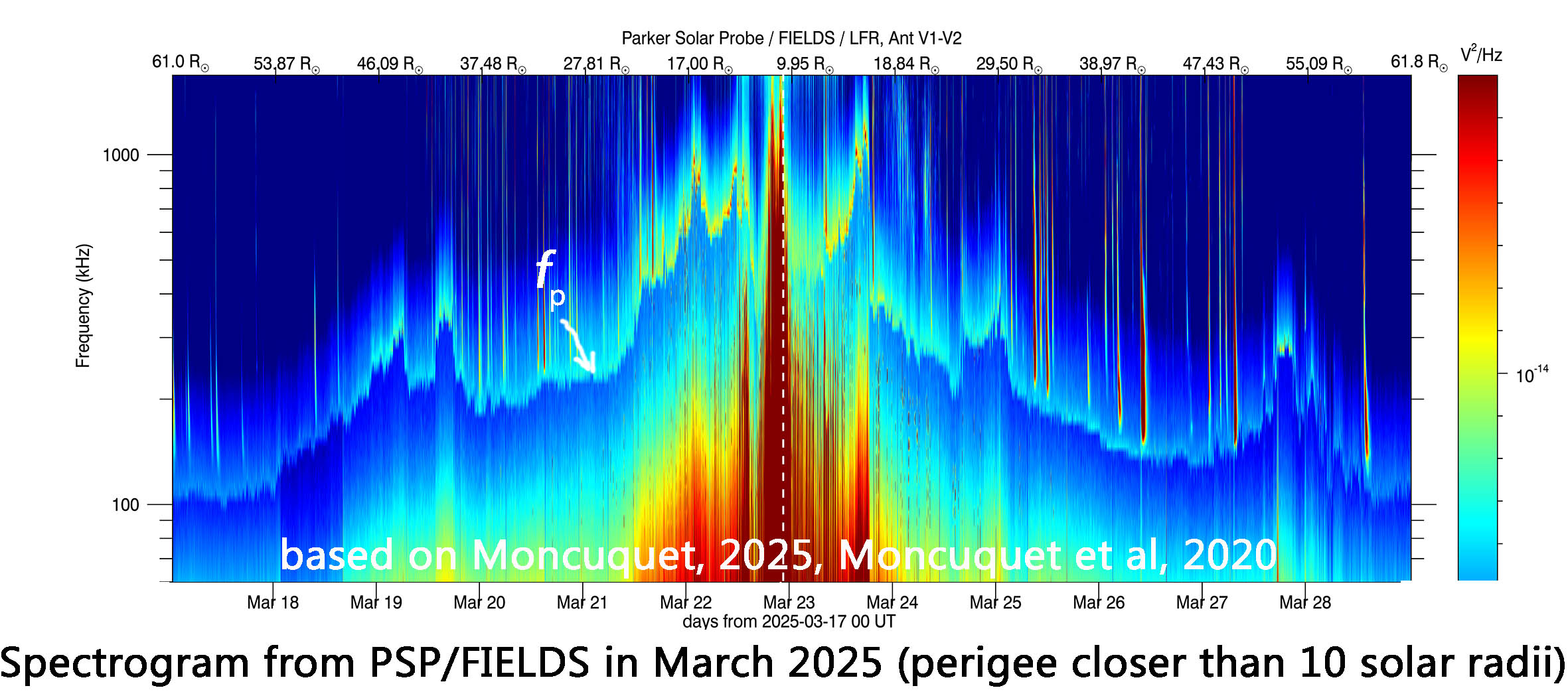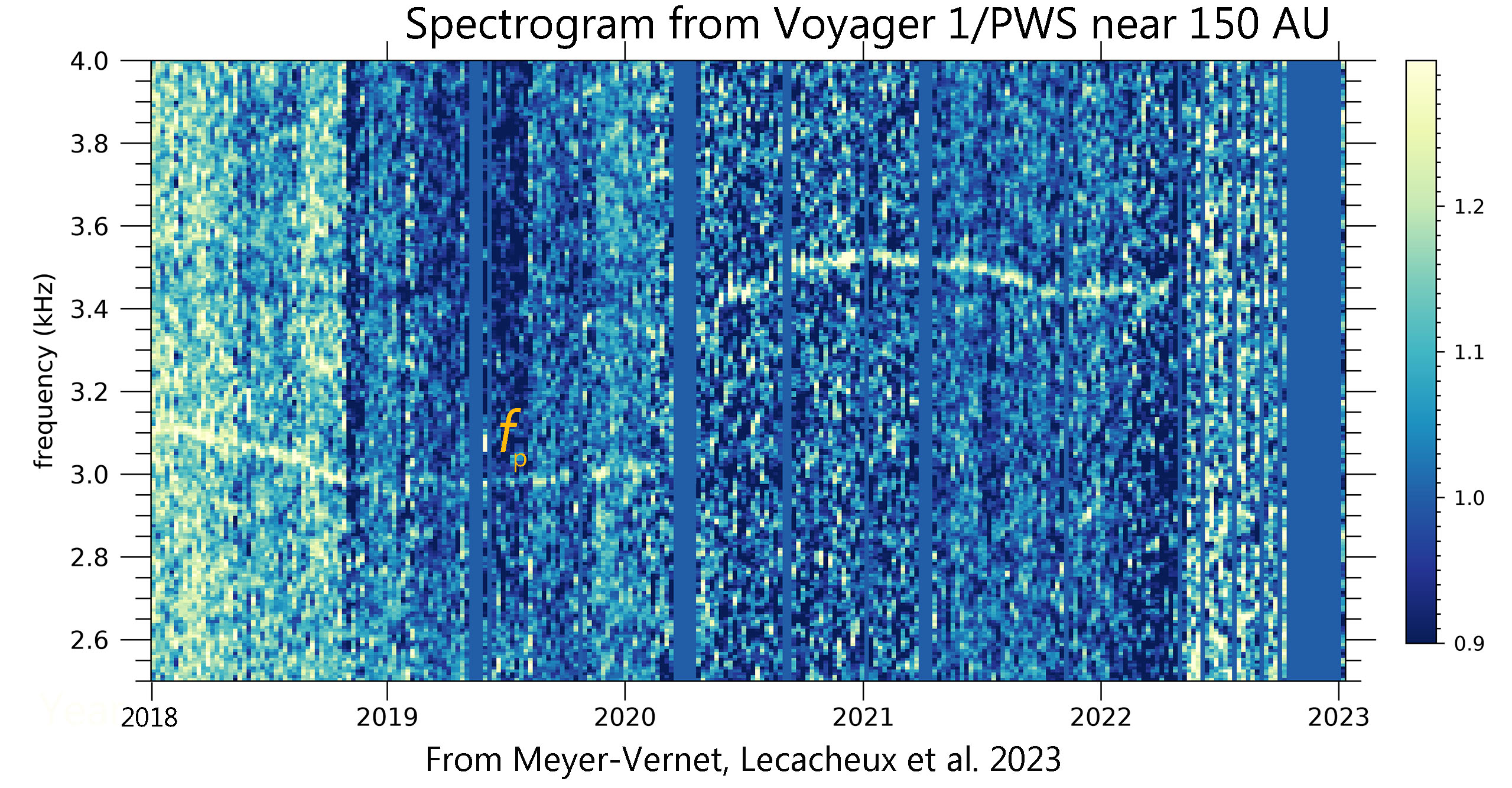Nicole Meyer-Vernet

Directrice de Recherche CNRS Émérite
LIRA, PSL, CNRS, Observatoire de Paris
5 Place Jules Janssen
92195 Meudon Cedex, France
nicole.meyer@obspm.fr
briefCV
Research
-
Basic physics (radiation, plasmas)
-
Physics of plasmas and dust in the heliosphere
-
Space missions (Voyager, ISEE3/ICE, Ulysses, WIND, Cassini, Parker Solar Probe, Solar Orbiter)
-
Measurement techniques for plasmas (conception and development of quasi-thermal noise spectroscopy) and dust in space
-
Basic properties of living organisms on Earth from fundamental constants
Pioneering work on in situ measurement of plasmas and dust in space with electric antennas

Quasi-thermal noise spectroscopy uses the spectrum of the electrostatic field measured by an antenna to deduce the electron density and temperature as well as suprathermal particles of the ambient plasma. It has been generalised to measure dust particles in space, including nanodust, via the cloud of electrons and ions produced by each dust impact on the spacecraft.
The quasi-thermal noise is produced by the quasi-thermal motion of the plasma particles, which produces an electrostatic field. The electrons produce Langmuir waves above the plasma frequency fp. Since the particles interact with waves having a phase speed equal to their speed, and the Langmuir wave phase speed increases close to fp, the fine structure of the plasma frequency peak reveals high energy electrons. Below the plasma frequency, the antenna measures the electrons passing closer than the Debye length to the antenna. Since the Debye length is determined by the core of the velocity distribution, this part of the spectrum reveals this part of the distribution.
This technique has been used in a cometary plasma tail, in the solar wind, in planetary magnetospheres (Earth, Jupiter and Saturn), and recently in the media closest to the Sun and farthest from it explored by space probes: the solar corona at 10 solar radii with Parker Solar Probe and the very local insterstellar medium at more than 150 astronomical units, with Voyager 1.


The organisms living on Earth, from bacteria to elephants and whales, use similar maximum energy per mass, can exert similar forces per cross-section, have similar maximum speeds per body length and have similar reaction times. These quantities can be expressed as a function of fundamental constants.

Publications
Publications with reprints available
Plasma measurements (heliosphere and local interstellar medium)
N. Meyer-Vernet, A. Lecacheux, M. Moncuquet, K. Issautier & W. S. Kurth, Plasma line detected by Voyager 1 in the interstellar medium: tips and traps for quasi-thermal noise spectroscopy, A&A 679, A 146, 2023
N. Meyer-Vernet, A. Lecacheux, K. Issautier & M. Moncuquet, Weak line discovered by Voyager 1 in the interstellar medium: quasi-thermal noise produced by very few fast electrons, A&A 658, L12, 2022
N. Meyer-Vernet & M. Moncuquet, Plasma Waves in space: the importance of properly accounting for the measuring device, J. Geophys. Res., 125, 2020
M. Moncuquet, N. Meyer-Vernet, K. Issautier et al., First in-situ Measurements of Electron Density and Temperature from Quasi-Thermal Noise Spectroscopy with Parker Solar Probe/FIELDS, ApJS Parker Solar Probe Special Issue, 2020
N. Meyer-Vernet, K. Issautier, M. Moncuquet, Quasi-thermal noise spectroscopy: the art and the practice, J. Geophys. Res., 122, 7925, 2017
N. Meyer-Vernet et al., Measuring plasma parameters with thermal noise spectroscopy, AGU-G.M.103, 205-210, 1998
N. Meyer-Vernet, S. Hoang & M. Moncuquet, Bernstein waves in the Io plasma torus : a novel kind of electron temperature sensor, J. Geophys. Res., 98, 21163, 1993
Y.F. Chateau, N. Meyer-Vernet, Electrostatic noise in non Maxwellian plasmas : generic properties and Kappa distributions, J. Geophys. Res. 96, 5825, 1991
N. Meyer-Vernet, C. Perche, Toolkit for antennae and thermal noise near the plasma frequency, J. Geophys. Res. 94, 2405, 1989
N. Meyer-Vernet et al., Plasma diagnosis from thermal noise and limits on dust flux or mass in comet Giacobini-Zinner, Science, 232, 370, 1986
N. Meyer-Vernet, On natural noises detected by antennas in plasmas, J. Geophys. Res. 84, 5373, 1979
Dust measurements
N. Meyer-Vernet, Will Nanodust Reappear in STEREO/WAVES Data? Research Notes of the AAS 9, 17 2025
N. Meyer-Vernet, M. Moncuquet, K. Issautier, P. Schippers, Frequency range of dust detection in space with radio and plasma wave receivers, J. Geophys. Res., 121, 8, 2016
P. Schippers, N. Meyer-Vernet, A. Lecacheux et al., Nanodust detection between 1 and 5 AU using Cassini wave measurements, Astrophys. J. 806:77, 2015)
N. Meyer-Vernet et al., The physics and detection of nanodust in the solar system, Plasma Phys. Control. Fusion 57, 014015, 2015
N. Meyer-Vernet et al., The importance of monopole antennas for dust observations:
Why Wind/WAVES does not detect nanodust, J. Geophys. Res. Lett. 41, 2716-2720, 2014
N. Meyer-Vernet et al., Dust detection by the wave instrument on STEREO: nanoparticles picked-up by the solar wind?, Solar Physics, 256, 453, 2009
N. Meyer-Vernet and A. Zaslavsky, In situ detection of interplanetary and jovian nanodust with radio and plasma wave instruments, Nanodust in the solar system: discoveries and interpretations, Springer 2012
N. Meyer-Vernet et al., Dust detection by the wave instrument on STEREO: nanoparticles picked-up by the solar wind?, Solar Physics, 256, 453, 2009
N. Meyer-Vernet et al., Detecting nanoparticles at radio frequencies: Jovian dust streams impacts on Cassini/RPWS, Geophys. Res. Lett. 36, L03103, 2009
N. Meyer-Vernet et al., Constraints on Saturn's E ring from the Voyager 1 Radio Astronomy Instrument, Icarus, 123, 113, 1996
Aubier, M.G., N. Meyer-Vernet, B.M. Pedersen, Shot noise from grain and particle impacts in Saturn's ring plane, Geophys. Res. Lett., 10, 5, 1983
Plasma physics
I. Zouganelis, N. Meyer-Vernet et al., Acceleration of weakly collisional solar-type winds, Astrophys. J. 626, L117, 2005
N. Meyer-Vernet, Large scale structure of planetary environments: the importance of not being Maxwellian, Planet. Space Sci. 49, 247, 2001
N. Meyer-Vernet, K. Issautier, Electron temperature in the solar wind: generic radial variation from kinetic collisionless models, J. Geophys. Res. 103, 29705, 1998
N. Meyer-Vernet, M. Moncuquet, and S. Hoang, Temperature inversion in the Io plasma torus, Icarus, 116, 202, 1995
Physics of dust
I. Mann, N. Meyer-Vernet, A. Czechowski, Dust in the planetary system: Dust interactions in space plasmas of the solar system, Physics Reports, 536, Issue 1, p. 1-39, 2014
N. Meyer-Vernet, On the charge of nanograins in cold environments and Enceladus dust, Icarus, 226, 583, 2013
N. Meyer-Vernet, Flip-Flop of electric potential of dust grains in space, A&A 105, 98, 1982
Physics of comets and small bodies
P. Vernazza et al., Asteroid colors: a novel tool for magnetic field detection? The case of Vesta, A&A 451, L43, 2006
Dynamics of disks
N. Meyer-Vernet, B. Sicardy, On the physics of resonant disk satellite interaction, Icarus 69 157, 1987
Miscellaneous: cosmic air showers, magnetic monopoles, focusing in astrophysics...
N. Meyer-Vernet, A. Lecacheux, and D. Ardouin, Radio pulses from cosmic ray air showers: Boosted Coulomb and Cherenkov fields, A&A, 480, 15, 2008
N. Meyer-Vernet, Energy loss by slow magnetic monopoles in a thermal plasma, Astrophys. J., 290, 21, 1985
N. Meyer-Vernet, G. Daigne and A. Lecacheux, Dynamic spectra of some ionospheric effects at decametric wavelengths - Applications in other astrophysical contexts, Astron. Astrophys., 96, 296, 1981
Physics and biology
J.-P. Rospars & N. Meyer-Vernet, How fast do mobile organisms respond to stimuli? Response times from bacteria to elephants and whales, Phys. Biol., 2021
J. P. Rospars, N. Meyer-Vernet, Force per cross-sectional area from molecules to muscles: a general property of biological motors, Royal Society Open Sci., 2016
N. Meyer-Vernet, J. P. Rospars, Maximum relative speeds of living organisms: why do bacteria perform as fast as ostriches?, Phys. Biol. 13 066006, 2016
Books, editions
Monograph: N. Meyer-Vernet, Basics of the solar wind , Cambridge University Press, 2007 - Review
Physics of Space: Growth Points and Problems (Kluwer Academic Publishers, 2001)
12th International Solar Wind Conference (AIP CP1216, 2010)
12th International Solar Wind Conference (AIP CP1216, 2010)
Nanodust in the Solar System: Discoveries and Interpretations (Springer, 2012)

General publications, teaching
General
Women in radio science, Radio Science Bulletin N°374, 2020
Radiation
Strange bound states in the Schrödinger wave equation: when usual tunnelling does not occur, Am. J. Phys. 50, 354, 1982
Electromagnetic waves in a plasma containing both electric charges and magnetic monopoles, Am. J. Phys. 50, 846, 1982
Surprises in classical physics: radiation problems in stable and linear plasmas, Eur. J. Phys. 5, 150, 1984
Ghost's shadows and superluminal occultations, Am. J. Phys. 54, 916, 1986
Non-radiating sources: the subtle art of changing light into black, Am. J. Phys. 57, 1084, 1989
Plasma physics, astrophysics
A plain man's guide to the cometary environment, Contemp. Phys., 32, 73, 1991
Aspects of Debye shielding, Am. J. Phys. 61, 249, 1993
Toolkit for space plasma physics, Cambridge University Press, 2007
How does the solar wind blow? A simple kinetic model, Eur. J. Phys., 20, 167, 1999
Introduction to the solar wind, Cambridge University Press, 2007
The trajectory of an electron in a plasma, Am. J. Phys. 76, 934, 2008
Basic properties of living organisms on Earth
How fast do living organisms move: maximum speeds from bacteria to elephants and whales, Am. J. Phys. 83, 719, 2015
Conférences et articles tous publics
Toucher le soleil et explorer d'autres mondes : une petite histoire de la conquête de l'espace (Univ. Auguste Rodin, Meudon, 3/2022)
Vents, Tempêtes Solaires et Parker Solar Probe (Stages 3ème, Observatoire Meudon, 12/2021)
Les vents et les tempêtes solaires (visioconférence Université Auguste Rodin, Meudon, 6/5/2021 )
Freedom, research and serendipity: the joy of discovery Radio Science Bulletin n° 374, September 2020, Women in Radio Science
Bulletin n°152 du CSSM (Février 2019): L'astrophysique à Meudon aujourd'hui
Les plasmas, quatrième état de la matière (Université Auguste Rodin, Meudon, 2017,
Observatoire des Makes, Ile de la Réunion, 2017)
Une sonde dans la couronne solaire l'Astronomie, 2011
Poussières dans le système solaire (Rencontres Ciel & Espace 2010)
La fin de la sonde spatiale Ulysses l'Astronomie, 2008
Aspects of solar wind physics (Université Catholique de Louvain, 2005)
Course Master 2: Plasmas en Astrophysique" (2000 - 2008)
Plan du cours
Cours n°1
Other links
Basics of the solar wind (Cambridge University Press, 2007)
Parker Solar Probe
International Space Science Institute team: Dust-plasma interactions
International Space Science Institute team: nanodust in the solar system
International Space Science Institute team: Non-equilibrium processes in the solar corona and their connection to the solar wind
International Space Science Institute team: Shocks, Waves, Turbulence, and Suprathermal Electrons in the VLIM
CODALEMA (Detection radio des rayons cosmiques)
"Theologians have their bells to ring: physicists have their laughter" (Bertolt Brecht in Life of Galileo, translated by John Willett, New York, Arcade Publishers)






